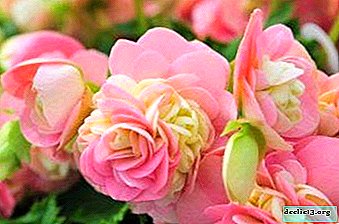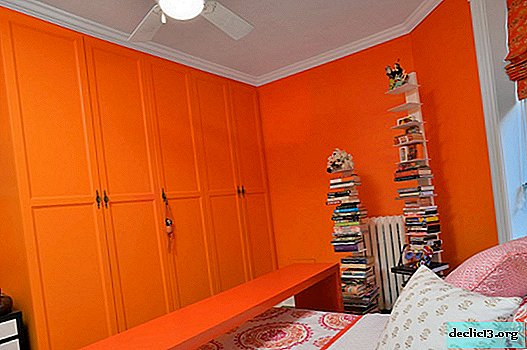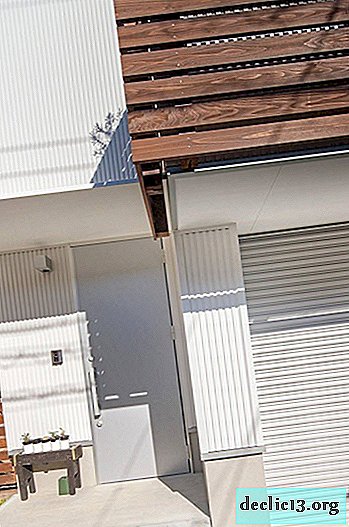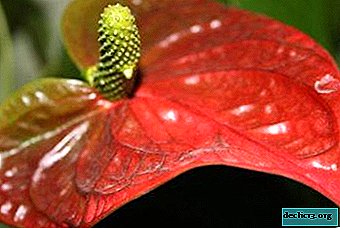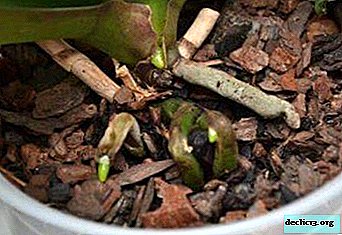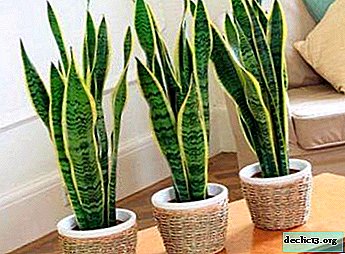Flower "Women's happiness" or spathiphyllum - the secrets of home care
 Many people love this elegant beautiful plant native to the tropics. Ornamental leaves themselves are beautiful, but Spathiphyllum also blooms. White thin sail (bract) as if soars above an inflorescence in the form of an ears. This flower, in addition, is one of the few that does not need bright sunlight, it can perfectly grow on the northern window and in partial shade of other flowers standing on the windowsill.
Many people love this elegant beautiful plant native to the tropics. Ornamental leaves themselves are beautiful, but Spathiphyllum also blooms. White thin sail (bract) as if soars above an inflorescence in the form of an ears. This flower, in addition, is one of the few that does not need bright sunlight, it can perfectly grow on the northern window and in partial shade of other flowers standing on the windowsill.
We will talk about how to properly care for a flower and other secrets of success in growing this plant in our article. Also watch a useful video on this topic.
The importance of the correct content of “Women's happiness”
Thanks to the proper care of the plant, it will give you the opportunity to enjoy wonderful flowering, and if you treat it carelessly, you can simply not wait for the flowering, and the leaves will lose their decorative appearance over time and begin to dry out.
How to care for him?
The peculiarity of Spathiphyllum itself is that it does not have a stem; leaves grow directly from the ground. As for care, the following features can be distinguished:
- the flower grows beautifully in partial shade, does not require bright lighting;
- very picky about moisture, you can not allow the drying out of an earthen coma; as soon as he starts to lower the leaves slightly, he needs to be urgently watered;
- he has a weak root system; when transplanting, one must not forget about it.
Basic requirements for indoor plant maintenance
The most important thing in proper care is to provide all the necessary needs of Spathiphyllum, create comfortable conditions for it and prevent various diseases and attacks of harmful insects.
Dependent care:
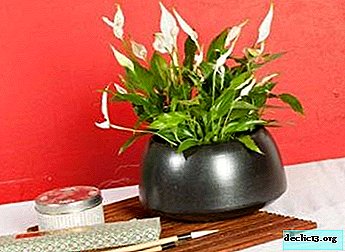 From the time of year - Spathiphyllum must have a rest period in order for flower buds to form correctly, this period falls on the winter, therefore winter care is somewhat different from other periods:
From the time of year - Spathiphyllum must have a rest period in order for flower buds to form correctly, this period falls on the winter, therefore winter care is somewhat different from other periods:- in winter, the temperature is needed about 16 degrees, watering is reduced and feeding is not needed;
- spring care - the temperature gradually increases to 22 degrees, watering increases, the spraying of the plant resumes, fertilizing is applied 2 times a month;
- summer care - continue to intensively water, apply fertilizers, bathe in the shower once a week, constantly spray and protect from bright sunlight;
- leaving in the fall - after the end of flowering we remove the peduncle (you need to cut it as low as possible), gradually (starting from October) we begin to lower the temperature and reduce watering.
- From flowering plants - before flowering, the plant is taken care of according to all the rules, without losing anything, and during flowering it needs more than usual fertilizing (buying in the store is already balanced),ATTENTION: It is very important not to forget about the shower (at least once a week), but only so that water does not get on the flower. After flowering, one gradually needs to prepare for a dormant period.
- From the view of Spathiphyllum - at home, you can successfully grow different types of Spathiphyllum: large and miniature, with green and variegated leaves, with white and cream flowers, but the rules for caring for them are no different.
Step-by-step instructions for beginners on how to care
The first steps after purchase - after you have brought the spathiphyllum plant from the store home, you need to try to transplant it into a new pot with the correct substrate for several days. Indeed, in the sold containers, soil nutrition is designed only for the period of sale, so the sooner you transplant the plant and begin to properly care for it, the less stress it will have to endure. It will immediately begin to adapt to good conditions.
- Pot selection - the pot does not need to be taken large, it should differ from the previous one by only 2 cm, not more (so with each transplant). As for the material for the pot, it doesn’t really matter, since the main thing for the plant is female happiness - how to care for it, then the flower will grow beautifully in both plastic and ceramic, but the ceramic should be coated with glaze from the inside, then it will not be able to absorb moisture (the roots need it).
- Substrate preparation - It is best to purchase ready-made soil for Aroid plants, but you can, of course, make it yourself. To do this, take leafy humus and soddy ground (equally), add sand and peat to them, it is important to remember that the substrate should be loose and light, then the plant will develop correctly and successfully.
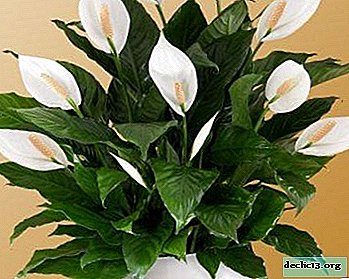 Seat selection - The northern window is the best place for Spathiphyllum in spring and summer, in the autumn and winter it will feel better on the eastern or western window, since the plant is thermophilic, it is necessary to ensure the reliability of the window - so that there are no clicks, it is not blown out anywhere.
Seat selection - The northern window is the best place for Spathiphyllum in spring and summer, in the autumn and winter it will feel better on the eastern or western window, since the plant is thermophilic, it is necessary to ensure the reliability of the window - so that there are no clicks, it is not blown out anywhere.- Watering - very fond of water, especially in spring and summer, watered only with settled soft water.
- Top dressing - You need to feed in spring and summer with complex fertilizer for flowering plants once every two weeks.
- Lighting - the soft diffused light is preferable, because it is a tropical plant, if the windows in the apartment overlook only the sunny side, then the flower will need to be shaded or placed not on the windowsill, but on a stand about a meter from the window.
- Temperature - in spring and summer, the suitable temperature for the plant is 22 - 25 degrees, in winter it is advisable not to allow a decrease of less than 16 degrees.
- Humidity - Naturally, Spathiphyllum needs high humidity, it will be useful to put the pot with the plant in a pan with expanded clay or pebbles flooded with water, due to the evaporation, the air humidity around the flower increases. It would be ideal to increase humidity with a humidifier. It is also good to put a decorative fountain near the plant.
- Spraying - the flower responds very well to spraying with warm water (or room temperature) from the spray bottle, this can be done daily, but only by leaves, water should not fall onto the flowers.TIP: Also, the plant loves the shower (warm) very much, once a week it is necessary to bathe it.
- Transfer - it is required as necessary, small bushes need to be replanted every year, and adults already about 1 time in 3 years, but for them (adults) every year it is necessary to change the topsoil to a new one. Transplant should be in the spring:
- at the bottom, it is necessary to first fill the drainage layer;
- then place the plant and carefully pour new soil on the sides and slightly on top;
- then pour and put in place.
Watch a video about the rules for the care of spathiphyllum at home:
Mistakes
Improper care is inattention to the needs of the plant:
- dry indoor air;
- bright lighting, direct sunlight on the flower;
- sparse watering or too frequent watering;
- the temperature is incorrect;
- wrong pot selected (too large);
- the plant is planted in the wrong substrate.
Effects
Due to poor maintenance, the plant will begin to suffer greatly and may die over time..
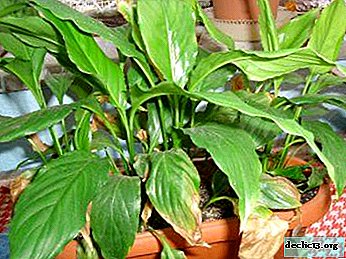 It becomes easy prey for various insects - pests, as it becomes weakened.
It becomes easy prey for various insects - pests, as it becomes weakened.- Also, because of the dry air, the tips of the leaves quickly turn brown and gradually the entire leaf dries out.
- The leaves turn yellow, usually also due to dry air and insufficient watering.
- The leaves turn black - these are the consequences of too low air temperature and excess moisture (watering and spraying).
- From a lack of water, the leaves immediately wilt and fall down, if you do not water them immediately, the earthen lump will dry up (this happens quickly) and it will be quite difficult to save the plant.
- A plant may not bloom for a long time, but only grow green mass due to the fact that the wrong pot was chosen - it turned out to be too large than necessary, therefore all the forces of the plant go to growth, and not to flowering, until the roots fill the pot, Spathiphyllum does not bloom will start.
- Very slow plant growth occurs mainly due to over-abundant watering, but everything is good in moderation, you need to focus on the air temperature and the condition of the leaves - if they look up sharply, then it is too early to water, and if they start to lower the tips a little down, then it's time to water.IMPORTANT: It is also worth remembering that fertilizers can be applied only after irrigation, and not in dry ground.
What are pests?
Insects are pests that are most often able to harm Spathiphyllum, these are:
- aphid - a small insect sucking juice from the leaves - the leaves curl;
- spider mite - sucks the juice from the back of the leaves, yellow spots and a thin cobweb appear;
- scale shield - brown "plaques" are noticeable on the underside of the leaf - the leaf begins to turn yellow and become covered with a coating.
You need to help with the treatment with "Aktara" or "Aktellik", the plant will need to be isolated for some time from others.
Watch a video about spathiphyllum pests and how to deal with them:
What diseases
If you notice the appearance of brown spots on the leaves, then most likely the plant suffers from stagnation of water and the roots begin to rot, in this case, an urgent transplant into a new soil will be required and then you need to make sure that the roots do not touch the water (when the pot is standing in a pan with water on pebbles, it should stand on pebbles, and not directly in the water).
If young leaves curl up and sharply turn pale - the matter is in the wrong soil. It is too dense (and requires loose), so thin roots cannot develop normally.
Conclusion
In addition to beauty, Spathiphyllum also has useful qualities, it is able to moisten the air, saturate it with volatile and ions (the air becomes like in the mountains). Also, this plant perfectly cleans the air of various harmful substances: carbon monoxide, xylene, benzene and others.
An interesting detail - for some reason, among the flower growers, Spatiphyllum was nicknamed “Feminine Happiness,” and for good reason. Each woman needs it to help make her happy - during flowering, the flower gives the energy of well-being and love.

 From the time of year - Spathiphyllum must have a rest period in order for flower buds to form correctly, this period falls on the winter, therefore winter care is somewhat different from other periods:
From the time of year - Spathiphyllum must have a rest period in order for flower buds to form correctly, this period falls on the winter, therefore winter care is somewhat different from other periods: Seat selection - The northern window is the best place for Spathiphyllum in spring and summer, in the autumn and winter it will feel better on the eastern or western window, since the plant is thermophilic, it is necessary to ensure the reliability of the window - so that there are no clicks, it is not blown out anywhere.
Seat selection - The northern window is the best place for Spathiphyllum in spring and summer, in the autumn and winter it will feel better on the eastern or western window, since the plant is thermophilic, it is necessary to ensure the reliability of the window - so that there are no clicks, it is not blown out anywhere. It becomes easy prey for various insects - pests, as it becomes weakened.
It becomes easy prey for various insects - pests, as it becomes weakened.
